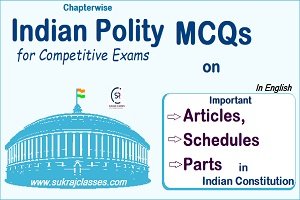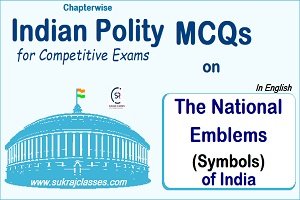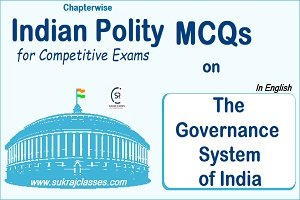
Indian Polity MCQs on The Constitutional Development of India
Indian Polity MCQs on The Constitutional Development of India, are important questions for all competitive exams i.e. UPSC, SSC, Railways, Banking, CET etc. Many questions were asked in pervious year’s exams from this topic. Let’s start the topic:
Que- 1. Which of the following Acts introduced the ‘Principle of Constitutional Autocracy’?
(A) The Indian Councils Act of 1909
(B) The Government of India Act of 1919
(C) The Government of India Act of 1935
(D) The Indian Independence Act of 1947
Que- 2. Which Act of British Parliament abolished the East India Company monopoly over trade in India?
(A) Regulating Act
(B) Pitt’s India Act
(C) Charter Act of 1813
(D) None of the above
Que- 3. The Federal Court of India was established in which of the following year?
(A) 1935
(B) 1937
(C) 1946
(D) 1947
Que- 4. Member of constituent assembly, who drafted the Constitution of India, were
(A) Nominated by British Parliament
(B) Nominated by Governor- General
(C) Elected by legislative assemblies of various provinces
(D) Elected by Indian National Congress and Muslim League
Que- 5. By which one of the following Acts was the Federal Court in India created?
(A) Indian Council Act, 1861
(B) Government of India Act, 1909
(C) Government of India Act, 1919
(D) Government of India Act, 1935
Que- 6. In which of the following Acts, the provision was made for the establishment of Supreme Court at Calcutta?
(A) Regulating Act, 1773
(B) Pitt’s India Act, 1784
(C) Charter Act, 1813
(D) Charter Act, 1833
Que- 7. By which of the following Act, Legislative Council of India received the power to discuss the budget?
(A) Indian Council Act, 1861
(B) Indian Council Act, 1892
(C) Indian Council Act, 1909
(D) Indian Council Act, 1919
Que- 8. Under which of the following Acts, Dyarchy was introduced at Central level?
(A) Act of 1909
(B) Government of India Act, 1919
(C) Government of India Act, 1935
(D) Indian Independence Act, 1947
Que- 9. In the context of Indian history, the principle of ‘Dyarchy (diarchy)’ refers to ___?
(A) Division of the central legislature into two houses
(B) Introduction of double government i.e., Central and State Governments
(C) Having two sets of rulers; one in London and another in Delhi
(D) Division of the subjects delegated to the provinces into two categories
Que- 10. The Act of 1909 was associated with ___?
(A) Introduction of separate electorate
(B) Decentralization
(C) Dyarchy
(D) Legislative Councils
Que- 11. Which of the following Acts set up Dyarchy System at the central level?
(A) Government of India Act, 1935
(B) Government of India Act, 1919
(C) Indian Councils Act, 1909
(D) Indian Councils Act, 1892
Que- 12. The Indian Legislature was made bi-cameral for the first time by__?
(A) Indian Council Act of 1892
(B) Indian Council Act of 1909
(C) The Government of India Act of 1919
(D) The Government of India Act of 1935
Que- 13. The power of the President to issue ordinance is a relic of ____?
(A) G.O.I. Act, 1919
(B) G.O.I. Act, 1935
(C) G.O.I. Act, 1909
(D) Indian Independence Act, 1947
Que- 14. Which of the following Acts introduced a bi-cameral legislature at the Centre?
(A) 1961 Act
(B) 1917 Act
(C) 1919 Act
(D) 1915 Act
Que- 15. The distribution of power between Centre and States as in the Constitution of India is based on which of the following plans?
(A) Morely-Minto Reform, 1909
(B) Montagu-Chelmsford Reform, 1919
(C) Government of India Act, 1935
(D) Indian Independence Act, 1947
Que- 16. Which Act for the first time made it possible for Indians to take some share in the administration of their country?
(A) Charter Act, 1833
(B) Charter Act, 1853
(C) Government of India Act, 1858
(D) Indian Councils Act, 1861
Que- 17. The provision for the establishment of All India Federation was included in the __?
(A) Government of India Act, 1935
(B) August Offer, 1940
(C) Government of India Act, 1919
(D) Cabinet Mission Proposal, 1946
Que- 18. A ‘Federal System’ and ‘diarchy’ at the ‘Centre’ was introduced in India by __?
(A) The Act of 1909
(B) The Act of 1919
(C) The Act of 1935
(D) None of the above
Que- 19. In the Federation established under the Act of 1935, residuary powers were given to the __?
(A) Federal Legislature
(B) Provincial Legislature
(C) Governor-General
(D) Provincial Governor
Que- 20. Which one of the following Acts provided for a federal polity in India?
(A) Government of India Act, 1909
(B) Government of India Act, 1919
(C) Government of India Act, 1935
(D) India Independence Act, 1947





